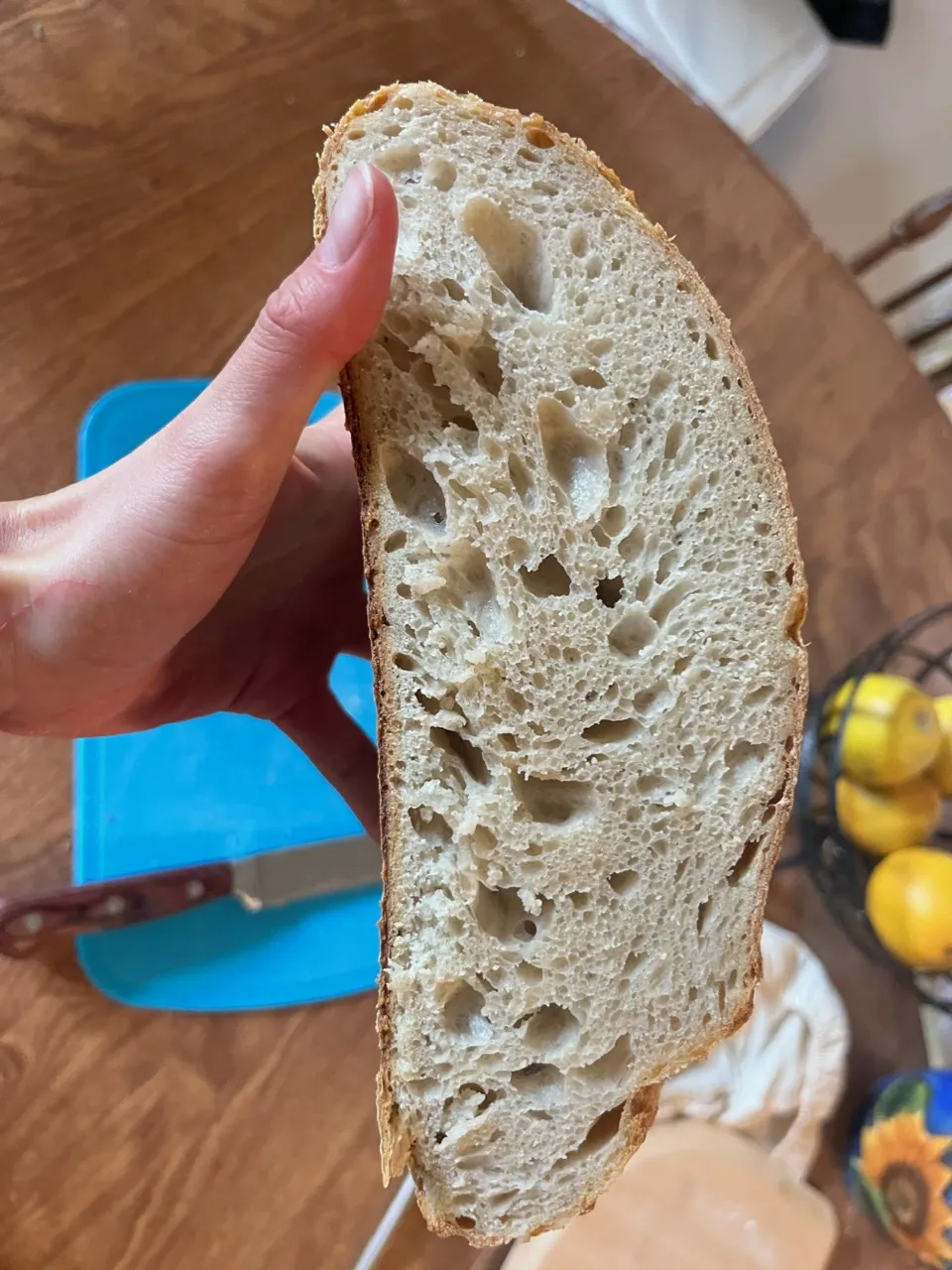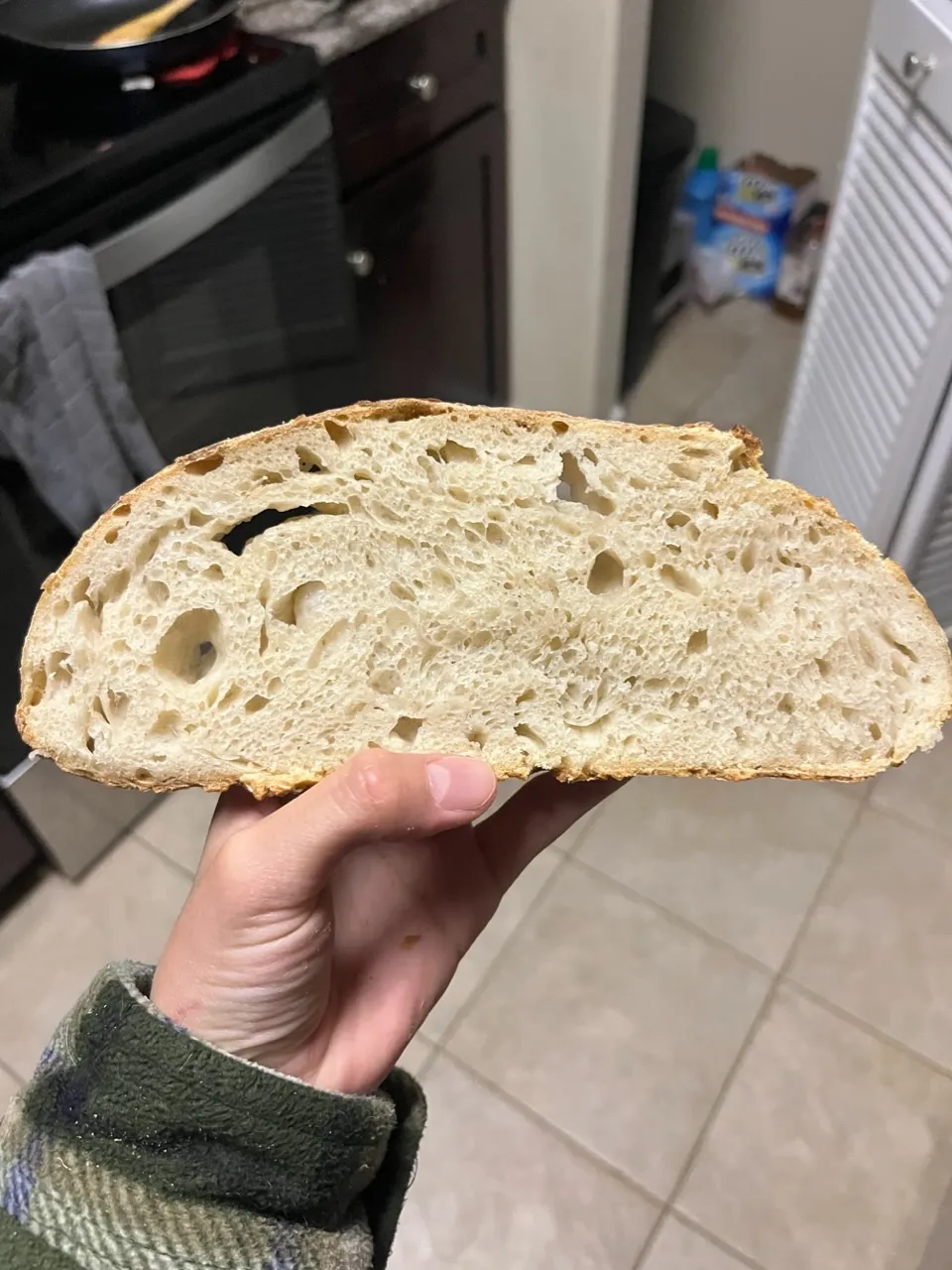
New to sourdough! I’ve made a few loaves now… oddly enough, my best loaf so far has been my first a couple weeks ago. This is one that I baked yesterday, and it had the large holes that I’ve been trying for but I’m also worried that the surrounding structure is too dense- is it maybe underproofed?
I see a lot of conflicting information regarding how much to let the dough rise during the bulk ferment. I’ve seen people swear by as low as 30% and others insisting it needs to double. What do y’all recommend?
I don't feel like I'm necessarily good at judging whether something is over or under proofed vs. other issues. I would think this is probably a bit underproofed. Personally, I had my biggest bread breakthrough when I went from doing a 3-4 hr bulk fermentation just kind of by rote to doing a bulk fermentation of 11+ hrs and thinking a lot more about the room temperature.
For reference, I usually use around 11% starter, and the 11 hr. bulk fermentation probably corresponds to a room temp. around 70.
If you want some guidlines about time vs. temp. vs. starter %, this is a useful table: http://www.wraithnj.com/breadpics/rise_time_table/bread_model_bwraith.htm
Cheers to good bread!
I am the furthest thing from an expert, but I'll weigh in :)
First off, kudos...if you are, as you say, new to SD baking this is not a bad result! You don't say how long your bulk ferment was (nor temperature, nor % rise), but to my eye this exhibits signs of (slight) over-fermentation: the tight, irregular, ragged crumb and the lack of "shoulders" on the loaf. FYI, this guide has helped me troubleshoot fermentation issues, perhaps it'll help you too:
https://thesourdoughjourney.com/wp-content/uploads/2021/12/How-to-Read-a-Sourdough-Crumb.pdf
Di
The overall dense crumb suggests under fermentation of the dough. The slopping shoulders in this case suggests insufficient gluten development to me rather than over fermentation.
To assess the proofing/fermentation ignore the big holes first. What is the crumb like, are the alveoli in the crumb tiny and tight then more likely to be underfermented. Is the crumb overall actually pretty nice and not tight then not underfermented. Then the large hole characteristics next. Are there large tunnels through the bread and not necessarily immediately under the crust? This along with the tight crumb equals underfermented. Are the large holes immediately under the crust? Do these large holes show in them signs of gluten breakdown with thin broken gluten strands? Then this points towards overfermented. Then look at the profile of the loaf, decent oven spring or excessive oven spring is more associated with under proofing whereas flat profile is more associated with overproofing.
My first loaf from the original post was made with:
50 g starter
375 g water
500 g bread flour
9 g salt
I mixed the dough, then did 4 stretch and folds every thirty minutes over the course of two hours. I then let it bulk ferment on my counter overnight for about 9 hours, where it had roughly increased about 30%. I shaped it then let it proof in the fridge for 24 hours.
I just made a new loaf and doubled it to 100 grams starter and kept everything else the same. Same process but it increased about 75%, if not doubled, during the overnight bulk ferment. How do y’all think the crumb on this new loaf looks?
Image

The first was better. Let the starter mature before use - which is the biggest variable. Enjoy!
Maybe this is just muddying the water (re: Phaz's opinion) but I think that looks a bit nicer, more consistent crumb. Looks like you're getting some nice results; now the whole fun is in refining the process, experimenting, and enjoying new improvements!
Ultimately the most important factors are figuring out what processes yield good results for you regardless of rules and deciding what bread tastes good to you regardless of pictures and opinions.
There is definitely improvement there, you are going in the right direction.
May I suggest you develop the gluten a bit more early on? Add some slap and folds, you can start with 100-200, this will improve your gluten development and you’ll get a better rise. But this is going in the right direction. I think final proof can be extended, you may want to add an hour of room temperature final proof prior to refrigeration. Depending on the temperature of your fridge, you might not get a lot of CO2 production while the dough is in the fridge.
Benny